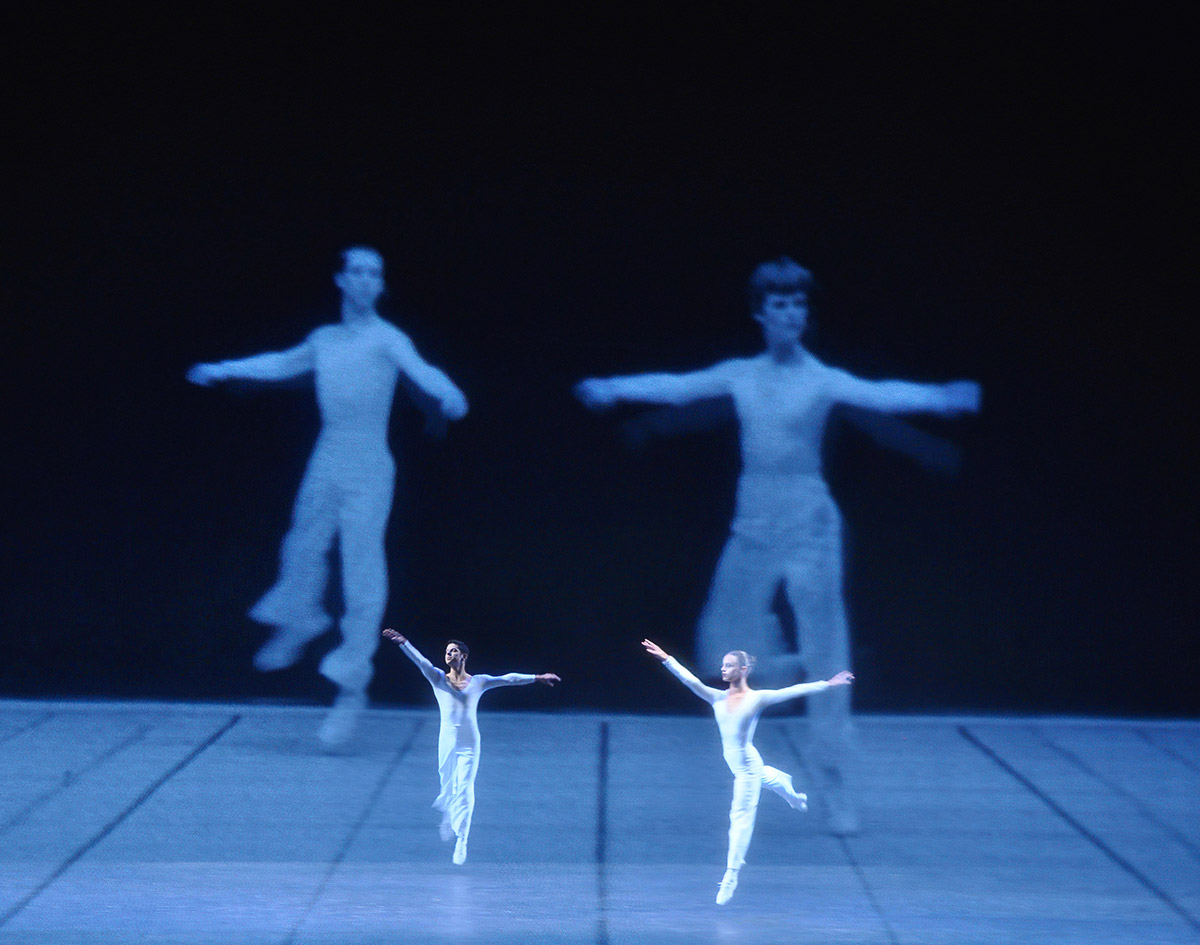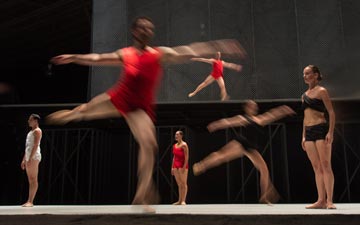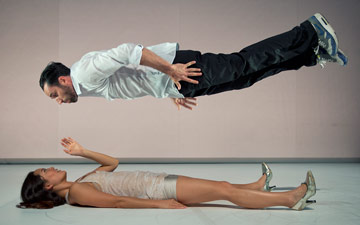
© Sally Cohn. (Click image for larger version)
Lucinda Childs
Dance
★★★★✰
New York, Joyce Theater
19 October 2021
lucindachilds.com
www.joyce.org
Lucinda Childs made her one-hour Dance in 1979 when first generation postmodernists, like herself, had already moved from the radical experiments of the 1960s to more mature work. Nevertheless, a patron at one performance threw eggs at the stage, demonstrating that controversy had not disappeared from Child’s work. When Dance was reconstructed in 2009, it was greeted with far more enthusiasm and toured internationally until 2018. Now it is again being presented, and judging from the audience’s response, the only things likely to be thrown are roses. Tuesday’s performance at the Joyce left little doubt that Dance can still dazzle.
The work brought together the talents of three major artists: Childs, Philip Glass, and Sol LeWitt. Childs responded to Glass’s minimalist score, and LeWitt to the music and dance, creating a black-and-white film montage that at once reflected what was happening onstage while adding another dimension to it. The film and live performance show mostly the same steps being danced at the same time, but LeWitt constantly changed perspectives so that sometimes the ghostly figures of the original dancers seem to be moving in front of the live dancers, sometimes behind them, or in split screens above or to the side. LeWitt also at times stop-framed the movement, or blacked it out completely. Throughout, dance, music, and film coordinate together while also working off and commenting on each other. The result is an extraordinary kaleidoscope of visual and aural stimulation.
LeWitt filmed the original cast of Childs’ dance company. These included Childs, herself, in a solo that makes up the central section of the piece, with four couples dancing the first and third sections. Today, of course, the dancers who are performing live are different from the filmed cast of forty years ago, and that difference adds yet another layer to the work. In the ’70s, Childs was using a limited vocabulary based on pedestrian movement, which she had developed in the 1960s. Eschewing virtuosity, the movement is made up largely of skips, shallow lunges, sideways jumps close to the ground, and simple turns. Although the torso and head are softly erect, the arms swing loosely, often in large arcs. In LeWitt’s film, the dancers of 1979 look focused but casual.
Today’s dancers, or at least the ones Childs has chosen for this incarnation of Dance, have had every ounce of “casual” trained out of them. They look like ballet dancers, each movement given a kind of ultimate form. So the little side leap that once descended immediately to the floor, is now stretched out and held for a moment in space, as if to implant the image of flight in the observer’s mind. Instead of modestly quotidian, the step puts itself on display, it demands attention. This kind of execution takes Dance into a very different realm from the one LeWitt’s film shows us. And it leaves the work open to debate as to how Childs’ original intentions may have changed. Some will argue that the original cast embodied an authentic postmodernism that has been lost. But Dance, as it currently exists, offers an unusual means of observing past and present simultaneously, which, in itself, is rewarding.
Childs said in an interview in 2011 that Dance isn’t about the movement vocabulary, which is relatively restricted, but what is done with it. Like Glass, she found an astonishing number of ways to use the materials she allowed herself. In the opening section the dancers move horizontally across the stage at high speed, subtly varying the movement so that it always remains interesting to the eye. The number of dancers, the spatial relationships between them, the patterns they create, shift so that the dance looks unified within itself and in relation to the music, while constantly being refreshed. The totality is a tour de force of timing, precision and discipline.
The solo of the central movement was danced by Caitlin Scranton at the Joyce, with Childs’ filmed shade accompanying her. Scranton wore her hair up, like Childs’ in the film, and looks a little like her. But it is hard to imagine anyone having Childs’ meticulous way of moving or her cool beauty, which LeWitt lingers on in the film. To my mind it would have been more interesting to have chosen a dancer who could have offered a contrast to, instead of an imitation of, the original. It’s impossible to know what went into Childs’ casting decision, but it didn’t work to Scranton’s advantage.

© Sally Cohn. (Click image for larger version)
The third and final section of Dance is structured around squares and circles, which replace the horizontal bands of the first section. Again, the variety and complexity Childs found in these basic structures are astonishing. As in the first section, couples predominate, often moving in unison. In other instances they face each other in structures resembling square dance figures. However, while the dancers move in pairs, they don’t touch. This sets Dance in opposition to both ballet and modern dance, and brings to mind Yvonne Rainer’s famous “no” manifesto of 1965, in which she laid out past dance forms that postmodernism would reject. No to the traditional pas de deux could have been added to her list.
While some may look back nostalgically to the postmodernism of the 1970s shown in LeWitt’s film, it is hard to fault the dancers of 2021, who represent a different time and training. Dance can look relatively simple to an observer, but it is, in fact, extremely demanding in its precision and sheer physical labor. So kudos to Shakirah Stewart, Robert Mark Burke, Sarah Hillmon, Matt Pardo, Sharon Milanese, Lonnie Poupard Jr., Katie Dorn, Patrick John O’Neill and Caitlin Scranton, who were the dancers appearing at the Joyce. And we should be grateful, too, for the opportunity to see Dance in its ever-evolving form. Surely in ten years it will look different still, as a new generation of dancers takes to the stage, accompanied by the ghostly images of 1979.

















You must be logged in to post a comment.